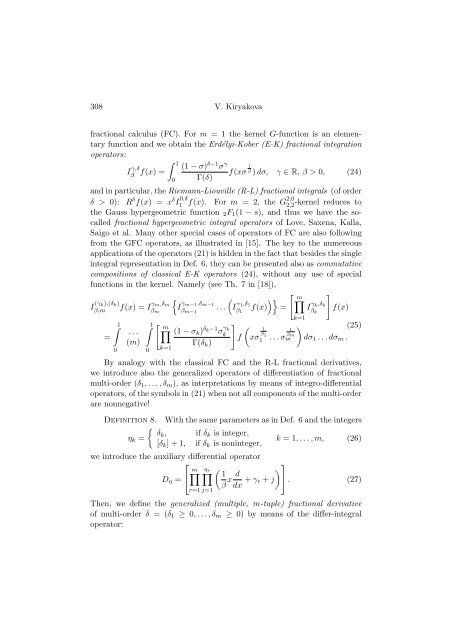VKiryakova_fcaa113
VKiryakova_fcaa113
VKiryakova_fcaa113
Create successful ePaper yourself
Turn your PDF publications into a flip-book with our unique Google optimized e-Paper software.
308 V. Kiryakovafractional calculus (FC). For m = 1 the kernel G-function is an elementaryfunction and we obtain the Erdélyi-Kober (E-K) fractional integrationoperators:∫ 1I γ,δβ f(x) = (1 − σ) δ−1 σ γf(xσ 1 β ) dσ, γ ∈ R, β > 0, (24)Γ(δ)0and in particular, the Riemann-Liouville (R-L) fractional integrals (of orderδ > 0): R δ f(x) = x δ I 0,δ1 f(x). For m = 2, the G2,0 2,2-kernel reduces tothe Gauss hypergeometric function 2 F 1 (1 − s), and thus we have the socalledfractional hypergeometric integral operators of Love, Saxena, Kalla,Saigo et al. Many other special cases of operators of FC are also followingfrom the GFC operators, as illustrated in [15]. The key to the numereousapplications of the operators (21) is hidden in the fact that besides the singleintegral representation in Def. 6, they can be presented also as commutativecompositions of classical E-K operators (24), without any use of specialfunctions in the kernel. Namely (see Th. 7 in [18]),[{( )} m]I (γ k),(δ k )β,mf(x) = I γm,δmβ mI γ ∏m−1,δ m−1β m−1. . . f(x) = I γ k,δ kβ kf(x)=∫ 10. . .(m)∫ 10[ m∏k=1I γ 1,δ 1β 1](1 − σ k ) δk−1 σ γ (kkf xσΓ(δ k )1β 11 . . . σ1βmmk=1)dσ 1 . . . dσ m .(25)By analogy with the classical FC and the R-L fractional derivatives,we introduce also the generalized operators of differentiation of fractionalmulti-order (δ 1 , . . . , δ m ), as interpretations by means of integro-differentialoperators, of the symbols in (21) when not all components of the multi-orderare nonnegative!Definition 8. With the same parameters as in Def. 6 and the integers{δk , if δη k =k is integer,k = 1, . . . , m, (26)[δ k ] + 1, if δ k is noninteger,we introduce the auxiliary differential operator⎡m∏ ∏η r (D η = ⎣ 1β x d ) ⎤dx + γ r + j ⎦ . (27)r=1 j=1Then, we define the generalized (multiple, m-tuple) fractional derivativeof multi-order δ = (δ 1 ≥ 0, . . . , δ m ≥ 0) by means of the differ-integraloperator:





